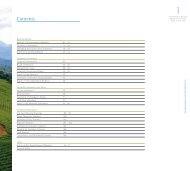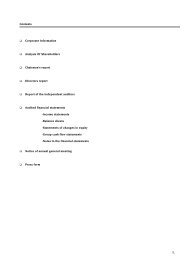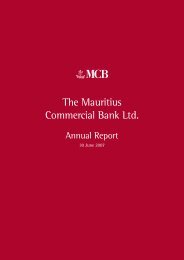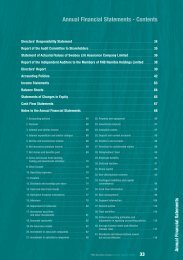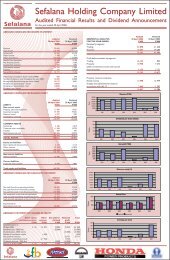Contents - Equity Bank Group
Contents - Equity Bank Group
Contents - Equity Bank Group
- No tags were found...
Create successful ePaper yourself
Turn your PDF publications into a flip-book with our unique Google optimized e-Paper software.
Notes to the Financial StatementsFor the year ended 31st December 2007The Risk Management Committee is responsible for monitoring compliance with the <strong>Bank</strong>’s risk management policies and procedures,and for reviewing the adequacy of the risk management framework in relation to the risks faced by the <strong>Bank</strong>. The Board Risk ManagementCommittee is assisted in these functions by Risk Management Department. Internal Audit undertakes both regular and ad-hoc reviews ofrisk management controls and procedures, the results of which are reported to the Board Risk Management Committee.(b) Credit riskCredit risk is the risk of financial loss to the <strong>Bank</strong> if a customer or counterparty to a financial instrument fails to meet its contractualobligations, and arises principally from the <strong>Bank</strong>’s loans and advances to customers and other banks and investment securities. For riskmanagement reporting purposes, the <strong>Bank</strong> considers and consolidates all elements of credit risk exposure.Management of credit riskThe Board of Directors has delegated responsibility for the management of credit risk to the <strong>Bank</strong> Management through the Chiefexecutive office. The Management has delegated this responsibility to various Credit committees as prescribed in the <strong>Bank</strong>s CreditCharter .A separate <strong>Bank</strong> Credit department, reporting to the Chief Executive Officer , is responsible for oversight of the <strong>Bank</strong>’s credit risk,including:• Formulating credit policies in consultation with business units, covering collateral requirements, credit assessment, risk grading andreporting, documentary and legal procedures, and compliance with regulatory and statutory requirements.• Establishing the authorisation structure for the approval and renewal of credit facilities. Authorisation limits are allocated to variousCredit committees as stipulated in the <strong>Bank</strong>s Credit Charter...• Reviewing and assessing credit risk. <strong>Bank</strong> Credit Committee assesses all credit exposures in excess of designated limits, prior to facilitiesbeing committed to customers by the business unit concerned. Renewals and reviews of facilities are subject to the same reviewprocess.• Limiting concentrations of exposure to counterparties, geographies and industries (for loans and advances) and by issuer, credit ratingband, market liquidity and country (for investment securities).• Developing and maintaining the <strong>Bank</strong>’s risk grading in order to categorise exposures according to the degree of risk of financial lossfaced and to focus management on the attendant risks. The risk grading system is used in determining where impairment provisionsmay be required against specific credit exposures. The current risk grading framework consists of five grades reflecting varyingdegrees of risk of default and the availability of collateral or other credit risk mitigation. The responsibility for setting risk grades lieswith the final approving executive / committee as appropriate. Risk grades are subject to regular reviews by <strong>Bank</strong> Risk.• Reviewing compliance of business units with agreed exposure limits, including those for selected industries, country risk and producttypes. Regular reports are provided to <strong>Bank</strong> Credit on the credit quality of local portfolios and appropriate corrective action is taken.• Providing advice, guidance and specialist skills to business units to promote best practice throughout the <strong>Bank</strong> in the management ofcredit risk.Each business unit is required to implement <strong>Bank</strong> credit policies and procedures, with credit approval authorities delegated from the <strong>Bank</strong>Credit Committee. Each business unit has a Credit Risk Manager who reports on all credit related matters to local management and the<strong>Bank</strong> Credit Committee. Each business unit is responsible for the quality and performance of its credit portfolio and for monitoring andcontrolling all credit risks in its portfolios, including those subject to central approval.Regular audits of business units and <strong>Bank</strong> Credit processes are undertaken by Internal Audit.2007 Annual Report and Financial Statements 43




